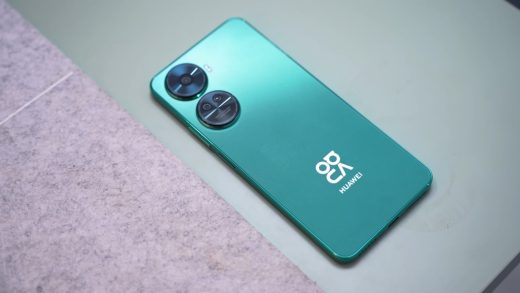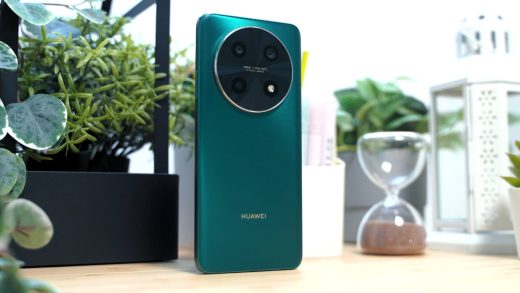We finally spent a good amount of time with Lenovo’s light, thin, and capable notebook, the Yoga S730. Like what we’ve said in our hands-on, it looks like an excellent laptop for users who need to be productive almost everywhere. It’s a bit pricey though, so we can’t help but ask if it’s worth getting. Find out in our review below.

Table of Contents
Design and Construction
One of the first things you’ll notice about the Yoga S730 is its thinness. At just 11.9 mm, it’s comfortable to hold. Lenovo even claims that it’s their thinnest Yoga laptop. It’s also light at 1.2 kg so that you can lug it comfortably.
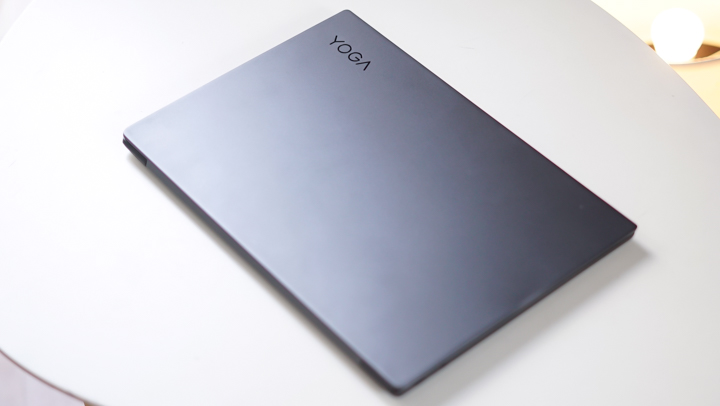
Despite the thin and light body, it still feels premium thanks to the aluminum body with a sandblasted finish. It looks clean and doesn’t attract a lot of fingerprints. We also like the glossy Yoga branding on the lid.
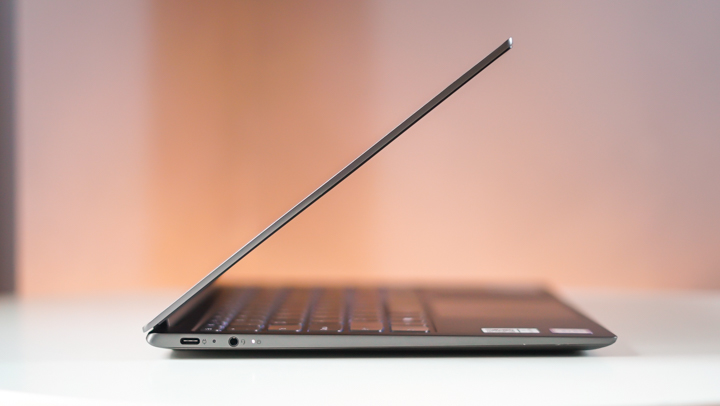
Looking at the left, we have the USB Type-C port for charging, 3.5mm audio port, and LED indicators.
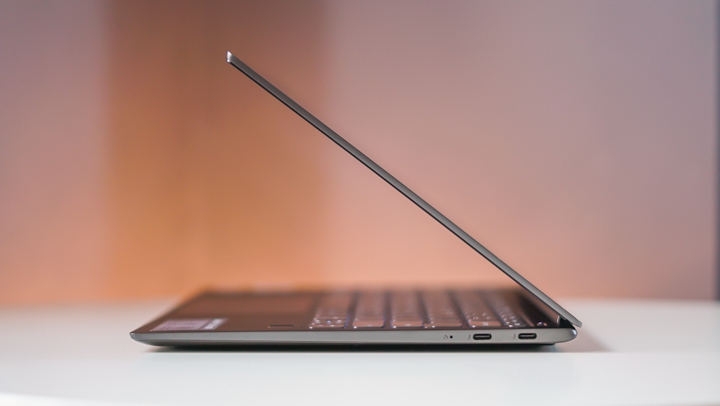
On the right are two USB Type-C ports that support DisplayPort, PD charging, Thunderbolt, and Always-on charging. The ports are very limiting, which is the price to pay for having a slim build such as this. If you need a USB-A port, you’ll need to buy an adapter as it doesn’t have one included in the package.
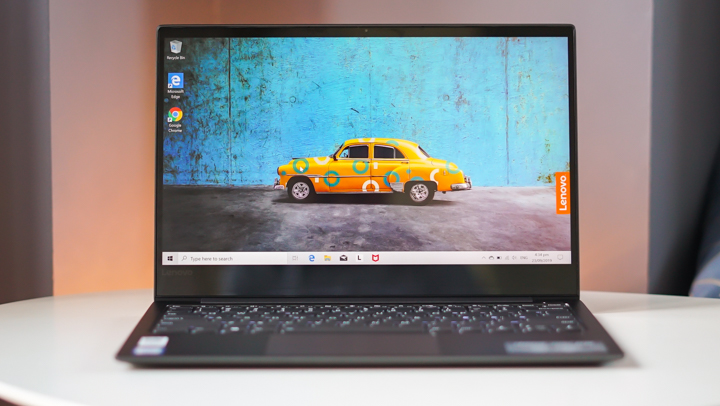
Inside, there’s the 13.3-inch Full HD IPS display with Dolby Vision. Placed at the top are the webcam and microphone.

The screen is connected to a sturdy and firm hinge that can flip up to 180-degrees to ensure that you’ll get the best viewing angle possible. Also located near the hinge is the intake vent.
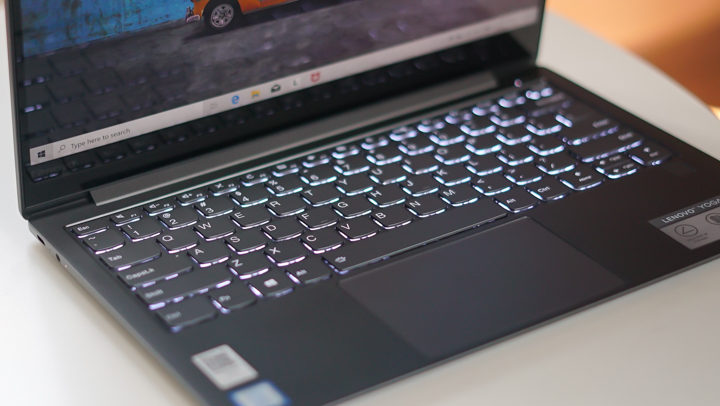
For the keyboard, we have six rows of chiclet keys with white two-stage backlighting. It’s quiet, has decent travel, and comfortable to type on. It’s great that Lenovo placed the power button away from the keyboard rows so you won’t accidentally press it.
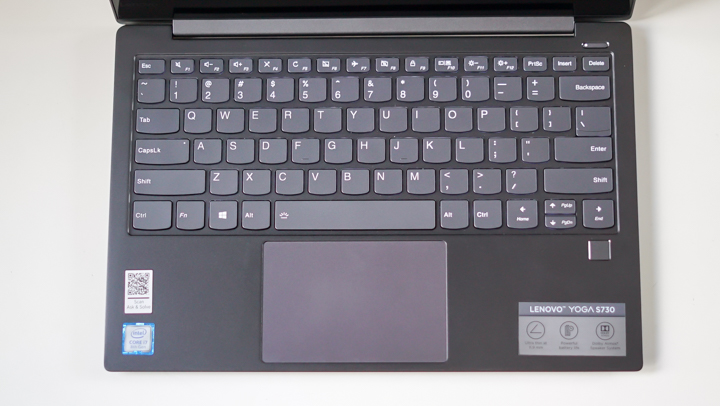
Below the keyboard is the large trackpad. It’s smooth and supports gestures. Placed on the right is the fingerprint scanner for added security and to let you log onto Windows with ease

At the bottom, you will find the rubber nubs, exhaust vent, and stereo speakers on the left and right-hand sides.
Again, one of the things we like about the Yoga S730 is its build. It’s compact meaning it doesn’t take up much desk space and room in our bag, it’s light so you can easily carry it around, it’s thin, and it’s premium. These factors also promote productivity as you can quickly whip it out and go to work right away.
Display and Multimedia
The Yoga S730 has a 13.3-inch screen with Full HD resolution and support for Dolby Vision. The screen size is smaller than what I’d like, but it doesn’t feel cramped thanks to the thin bezels. The viewing experience is also immersive, and we love how we can adjust the angle of the screen up to 180-degrees. It would have been nice if it had touch support, but it’s not a deal-breaker.

The screen has decent brightness, great viewing angles, and accurate colors. We also enjoyed watching videos on YouTube and Netflix on it. The stereo speakers sound pleasant and not tinny like those in cheap laptops. It could use some boost in loudness though, but if you’re watching alone, these should suffice.
OS and Apps
Running the software is Windows 10 Home 64-bit with the usual Windows pre-loaded applications like Office 265 and Skype. Other apps included are the Lenovo Vantage, LinkedIn, McAfee LiveSafe, and McAfee WebAdvisor.

Storage-wise, you’re getting a 512GB SSD with 465GB as usable. Lenovo’s website doesn’t say if you can install an HDD in this unit, but if this capacity is not enough, there’s a 1TB SSD model as well, but you’ll have to shell out more. Alternatively, you can also get an external hard-drive, instead.
Performance and Benchmarks
Powering the Yoga S730 is an 8th-gen Intel Core i7-8565U CPU, Intel UHD 620 Graphics, 8GB of RAM, and a 512GB SSD. It should be enough to run your productivity tasks such as working on documents and presentations, web browsing, and photo editing. The temperature is cool in most tasks, but you’ll have to put it on a desk when charging as the bottom part can heat up to uncomfortable levels. Check out the benchmark scores below:
- PCMark
- Geekbench 4
- CrystalDiskMark
Battery Life
For the battery life, Lenovo says that it can last for up to 12 hours. In our experience, we were getting around 8 to 9 hours of browsing, writing, watching YouTube, in Better Performance mode, and 60-70% brightness, which is not bad. Our video loop test, on the other hand, got us 10 hours and 14 minutes of playback. Charging using the Rapid Charger is quick and takes a little over an hour.
Conclusion
The Lenovo Yoga S730 is an excellent laptop with a premium yet compact build, an immersive display, and has enough horsepower to run most of our productivity tasks and entertainment. We like the inclusion of three USB-C ports with support for DisplayPort, Thunderbolt 3 and PD charging, but Lenovo didn’t include an adapter in the package considering the price.

For PHP 69,995, we can’t help but notice the ultrabooks from ASUS, HP, and Huawei that sport almost the same price tag but with extra features, including an MX GPUs. Again, the Yoga S730 is a great laptop, but we suggest looking at other options first if you want a better bang for your buck.
Lenovo Yoga S730 specs:
13.3-inch FHD (1920 x 1080) IPS display w/ Dolby Vision
180-degree clamshell design
8th-gen Intel Core i7-8565U CPU
Intel UHD 620 Graphics
8GB LPDDR3 RAM
512GB PCIe SSD
Dolby Atmos speakers
Fingerprint reader w/ Windows Hello
Webcam
2×2 WiFi 802.11 ac
Bluetooth 4.1
2x USB Type-C (DisplayPort, PD, Thunderbolt, Always-on Charging)
USB Type-C (DC-in)
3.5mm audio jack
Backlit keyboard
Windows 10 Home
307 x 210 x 11.9 mm
1.1 kg
What I liked:
• Premium, compact build
• Good performance
• 3 USB-C ports
• Nice display with thin bezels
• Good backlit keyboard w/ large trackpad
• Fingerprint scanner
What I didn’t:
• No dedicated GPU
• No USB-C adapter included
























